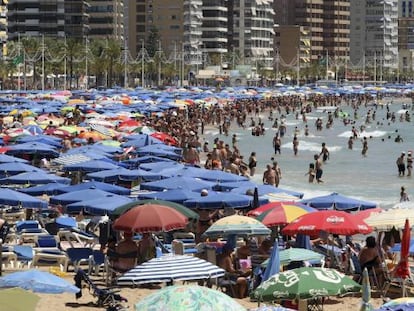Benidorm, the pioneering resort disdained in Spain but praised abroad
Applauded for its sustainability but vilified for triggering mass tourism, the coastal city has some of the most iconic skyscrapers in the country
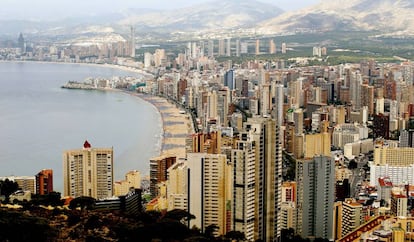
Like a city that springs up in the video game SimCity, Benidorm is often likened to a small version of Manhattan, a high-rise coastal resort whose vertical lines outrage some while fascinating others.
The legend of how it was founded is well known: during the Franco years, its mayor Pedro Zaragoza envisioned turning a small fishing village into a machine that would milk the developing tourism market in Spain. He reportedly even drove to Madrid on his Vespa scooter to sell his vision to the dictator, Francisco Franco, which included allowing topless bathing for the northern European sun-seekers.
“The Benidorm model was totally cutting-edge because it was a model for the whole city, with a vision for the future, something that was unusual at that time,” says the architect José Manuel Escobedo, a member of the city’s Urban Landscape Council who works out of the JAS studio. “More appreciated, as often happens, outside Spain than within.”
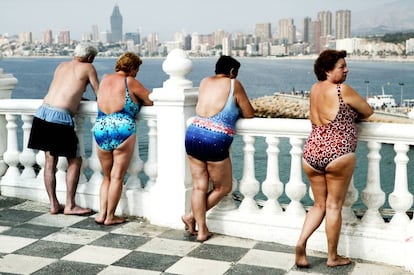
Escobedo uses a packet of cigarettes to illustrate the thinking behind the decision to grow upwards – if you lay it down on its biggest surface area, you have a model of construction that is no different to anywhere else, but if you balance it on its smallest surface area, you have skyscrapers that allow for land to be kept free for green zones, parking and pools. “Although it is compared to Manhattan, there is only one skyscraper here for every four there,” says Escobedo, adding that it is a more egalitarian resort than most. “Previously, the wealthiest occupied the beachfront properties, but here you can see the sea from every building.”
Writing in the collection of essays Trial and Error in Benidorm, the architects Carlos Ferrater and Xavier Martí, who won the 2011 National Architecture Award for the promenade along Poniente beach in Benidorm, say, “It’s possible that the Benidorm model has been one of the most sustainable along the Spanish Mediterranean coast on account of the small land area used – just a few hectares – and the very reduced use of private transportation due to the fact that anywhere in the city you are within 10 minutes walking distance from the beach.”
An eco-sustainable reality?

Although it might seem quite the opposite at first glance, the collection of skyscrapers in Benidorm is more ecological than other typical tourist resorts along the Mediterranean, such as the sprawling developments complete with golf courses, which use up a lot more land and energy and require more roads and means of transportation. Besides, Benidorm manages to attract tourists all year round, which means the resources and land are made full use of. While the city occupies just 1% of the Mediterranean coast in the Valencia region, it accounts for a large proportion of its tourists.
“It seems like a very open urban plan, but it is in fact very limited,” says Alejandro Muñoz, from the Interproyectos studio and also a member of the Urban Landscape Council. “For example, the buildings can’t be too close together and the fronts can’t be more than 50 meters [across]. You can always have a view of the beach. It seems very built up, but there are no closed blocks such as exist in big cities. Garden areas have been protected and there is still space to expand in the future.”
Muñoz goes on to say that the collection of needle-like buildings and their landmark elevation affords the city a very distinctive global image, explaining its application for recognition as a Unesco world heritage site, he adds, “There’s nowhere else like it.”
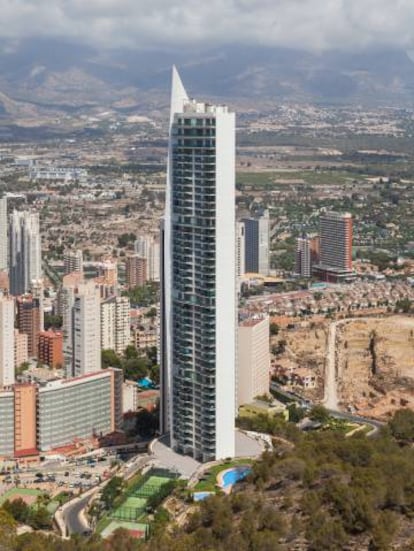
Iconic landmarks
The highest of Benidorm’s skyscrapers is Intempo, a Pérez-Guerras Architects & Engineers project, launched in 2006. It looks like a massive letter M with gold façades, and it rises above the rest of the city in the southwest corner, standing 192 meters tall, over 47 floors. The building has never been inhabited, however, as the collapse of the real estate sector reduced it to a white elephant and for years it stood as no more than a reminder of the Spanish property debacle.
Now, with new owners, the project has been revived and the apartments will be placed on the market, with prices expected to be in the range of €1 million for property on the top floors and in the central area that joins the two towers.
The Gran Hotel Bali is the second-highest building in Benidorm. It stands 186 meters tall, split into 52 floors. The hotel is the work of the late architect Antonio Escario and it opened in 2002. It is a symmetrical and svelte building with a base that gradually tapers off as it rises. As Escario told EL PAÍS at the time of its inauguration, “The size of the building is no mystery. To build it up, we used what is known in the profession as common sense.”
Due to its height, which trumped the Picasso Tower in Madrid, various events have been held there, such as an annual stair-climbing race and a base-jumping championship.
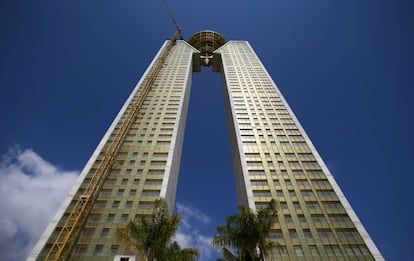
The third highest is the Lúgano Tower, which rises 158 meters and has 43 floors. The work of Adolfo Rodríguez, it may not be the tallest building per se but it is the highest feature of the Benidorm skyline, standing as it does 287 meters above sea level at the end of Levante beach in the area known as Rincón de Loix.
Fourth in terms of elevation is the Neguri Gane, reaching 145 meters over 43 floors. Designed by architects Roberto Pérez-Guerras and Julio Pérez Gegundez, it was inaugurated in 2002 with curves reminiscent of the ‘brutalist’ style of architecture evident in Sáenz de Oiza’s Torres Blancas in Madrid.
Coming in fifth is the Kronos building at 140 meters over 41 floors. Located on Levante beach near to Neguri Gane, it was designed by MAPRC.
Disdain or reverence
The city of Benidorm has been praised for its uniqueness and vilified for its crowded streets and beaches. “Only from the viewpoint of a culture that has turned exclusivity and individual choice into consensual slogans can the disdain for Benidorm be understood in cultural terms,” says town planner Iago Carro.
Meanwhile, Muñoz, maintains that much of the criticism reserved for Benidorm is unjustified. “But people are gradually understanding it better,” he says. “It’s just the opposite of what most people believe it to be and of the way it is portrayed by the media.”
Right now, Benidorm’s skyscrapers and its intense and multi-faceted lifestyle seem to be fashionable again. But not all its buildings are iconic and there is plenty of functional and poor quality construction. “What the city is lacking is for all the buildings to aspire to this benchmark; for the same investment, you can have a more dignified and interesting architecture,” says Escobedo. “You just need to work with the same budget but with more love.”
English version by Heather Galloway.
Tu suscripción se está usando en otro dispositivo
¿Quieres añadir otro usuario a tu suscripción?
Si continúas leyendo en este dispositivo, no se podrá leer en el otro.
FlechaTu suscripción se está usando en otro dispositivo y solo puedes acceder a EL PAÍS desde un dispositivo a la vez.
Si quieres compartir tu cuenta, cambia tu suscripción a la modalidad Premium, así podrás añadir otro usuario. Cada uno accederá con su propia cuenta de email, lo que os permitirá personalizar vuestra experiencia en EL PAÍS.
¿Tienes una suscripción de empresa? Accede aquí para contratar más cuentas.
En el caso de no saber quién está usando tu cuenta, te recomendamos cambiar tu contraseña aquí.
Si decides continuar compartiendo tu cuenta, este mensaje se mostrará en tu dispositivo y en el de la otra persona que está usando tu cuenta de forma indefinida, afectando a tu experiencia de lectura. Puedes consultar aquí los términos y condiciones de la suscripción digital.
More information
Archived In
Últimas noticias
Most viewed
- Reinhard Genzel, Nobel laureate in physics: ‘One-minute videos will never give you the truth’
- Oona Chaplin: ‘I told James Cameron that I was living in a treehouse and starting a permaculture project with a friend’
- Pablo Escobar’s hippos: A serious environmental problem, 40 years on
- Why we lost the habit of sleeping in two segments and how that changed our sense of time
- The fall of a prolific science journal exposes the billion-dollar profits of scientific publishing

